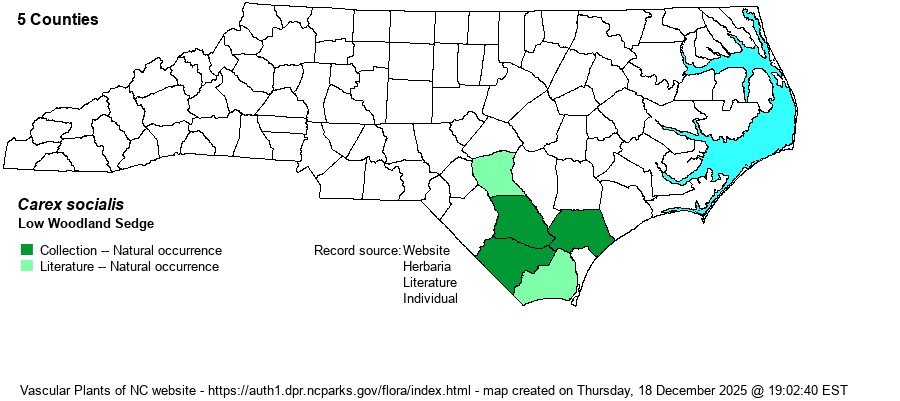| Author | Mohlenbrock & Schwegman | |
| Distribution | Coastal Plain only, mostly along the Cape Fear River. Distribution in NC not yet fully worked out.
Scattered locations, NC to GA and west to IN, IL, MO, OK, and TX. | |
| Abundance | Rare, although individual populations may be large. The NCNHP database lists only 5 records, confirming the S1 State Rank and the Significantly Rare status. | |
| Habitat | Floodplain forests and margins (for example, where crossed by roads). Found in both brownwater and blackwater systems. | |
| Phenology | Flowering and fruiting April-May. | |
| Identification | Its closest relative is C. radiata which is the default "star sedge" of floodplains. C. socialis differs by its elongate and tough, horizontal, knotty rhizomes, thus forming spreading colonies. C. radiata may appear to form colonies, but these really are patches of plants connected by short rhizomes. | |
| Taxonomic Comments | Originally described in 1969 from the Midwest.
The genus Carex is the largest in North America, and among the largest in the world. In temperate and boreal regions, Carex is often the dominant or co-dominant ground layer in many habitats. Seeds (achenes) are valuable food for birds and small mammals, while foliage is used by birds and mammals to make nests and as food by mammals. Species of Carex often look vastly different from one another -- spikes erect vs. drooping, tiny inflorescence vs. whopping, culms leafy vs. naked, perigynia beaked vs. beakless, stems densely bunched vs. single, etc. The genus has been divided into many sections (or groups), based on shared characters; some taxonomists have suggested that these be different genera, but that proves unworkable (so far). All Carex share the feature of a perigynium (an outer covering) which completely surrounds the achene (seed). This covering may fit tightly or loosely (like a small bladder), depending on which group or species. Details of perigynia shape, ornamentation, presence and size of beak, number of striations (or veins) are all important ID features. In recent years Rob Naczi and colleagues have stressed the importance of arrangement of perigynia -- whether spiral (3+ ranks) or distichous (2-ranked) -- and have named a number of new species as well as split off some older synonyms. Therefore, RAB's (1968) key, excellent for its time, can only be used in a general way today. Members of some sections of Carex are difficult to key out (notably Ovales, Laxiflorae, Griseae); this is in part due to variation among individuals of a species, or failings of the key. FNA has drawings of most species and some species may be found in two or more places within a key, to acount for variability. New species to NC, and new to science(!), continue to be found in NC. | |
| Other Common Name(s) | Social Sedge | |
| State Rank | S1 | |
| Global Rank | G4 | |
| State Status | SR-P | |
| US Status | | |
| USACE-agcp | | |
| USACE-emp | | |

